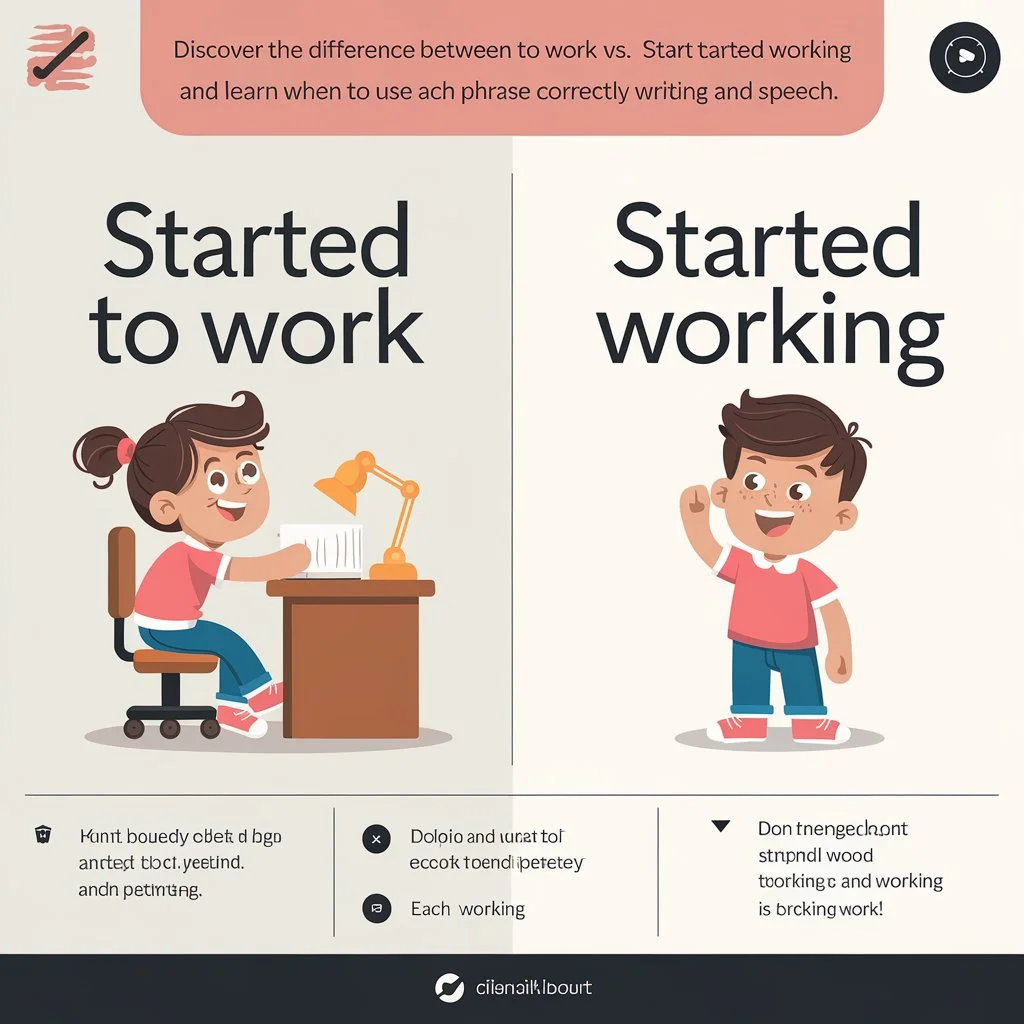Discover the difference between ‘Started To Work’ vs. ‘Started Working’ and learn when to use each phrase correctly in English writing and speech.”It’s crucial to grasp the difference between the infinitive form (e.g., “to work”) and the gerund form (e.g., “working”), especially when examining how these forms function with various verbs.
While this rule applies broadly in English, today, we’ll focus on the distinction between “started to work” and “started working.” Understanding the difference between the infinitive form (“to work”) and the gerund form (“working”) is essential when discussing actions in English. Both forms can convey subtle distinctions, especially when paired with verbs like “started.” For example, “started to work” may refer to a previous action resuming, while “started working” implies the beginning of a new action.
Though the rules are helpful, native speakers often use these phrases interchangeably. It’s crucial to grasp their meaning and correct usage, particularly in professional or academic settings.
Started to Work vs. Started Working
The phrase “started to work” should be used when someone or something resumes working after already being in a working state. In essence, it follows a more continuous form of action. On the other hand, “started working” is typically used when someone or something begins to work again after a significant break or for the first time. It indicates an initial start or resumption of activity after a pause or an entirely new beginning.
Interchangeability of the Phrases
That said, both “started to work” and “started working” are often used interchangeably in everyday speech. Most native speakers do not strictly adhere to the original independent meanings of these two phrases. Even though understanding the distinction is useful, in practice, it’s not always essential to follow the rules rigidly.
Should I Say: Has Started to Work or Has Started Working?
Including the auxiliary verb “has” in either phrase is grammatically correct, and both of the following are acceptable:
- He has started to work again.
- He has started working again.
In these sentences, “has” acts as an auxiliary or helping verb to support the verb “to work.” Whether you choose to include “has” or not, it doesn’t change the meaning significantly. The decision to use “has” adds a subtle variation in tense, as it suggests the action started in the past but still affects the present. For example:
- He started to work again.
- He started working again.
The “has” implies the work began in the past, while omitting “has” indicates the action is happening more in the present.
The Rule: Infinitive vs. Gerund
When deciding which form to use, keep in mind this simple rule:
- If you include “to” in the phrase, the verb stays in its infinitive form (e.g., “to work”).
- If you don’t include “to,” use the gerund form of the verb (e.g., “working”).
I Have Started Working vs. I Started Working
The inclusion of auxiliary verbs helps define the tense we’re speaking in, although they aren’t always necessary. For instance:
- I have started working again.
Here, “have” implies that the action of starting work began in the past and likely has ongoing consequences in the present. This means that the decision to work is final and likely already set in motion, such as signing a contract for a new job.
Alternatively:
- I started working again.
This phrase suggests the action is continuous and is happening in the present. This is the present continuous form, and it gives us flexibility to determine what happens next. We still have control over the situation.
Turning Them into Questions
Now, if we transform these statements into questions, we’ll notice a key difference:
- Have you started working again?
- You started working again?
In the second example, the sentence structure is incomplete and incorrect because it lacks the auxiliary verb “have.” This highlights why “have” is frequently used in questions to make them grammatically correct.
Examples: Correct vs. Incorrect Usage Of Started To Work vs. Started Working
Here are some examples to illustrate both correct and incorrect uses of “started to work” and “started working” in different tenses:
- Correct: I have started working on this project.
- Incorrect: I started to work for a company.
- Correct: I started working for this company last week.
- Incorrect: I started working tomorrow.
- Correct: I started working last week.
- Incorrect: I started working for this company since three years ago.
- Correct: I have started working on fixing myself.
- Incorrect: I have started to work at my job.
- Correct: I started to work at my job this morning.
- Incorrect: I started working on my designs all year.
- Correct: I have started working on the documents you asked me to.
- Incorrect: I have started working next week.
The incorrect examples mostly involve tense issues, where the wrong tense leads to grammatical errors. By adhering to the correct tense, you can make sure that both forms of “started” are used appropriately.
What Tense Is “Started Working”?
“Started working” is used in the present continuous tense. This indicates that while the action began in the past, it is still continuing into the present.
The continuous tense suggests that the action hasn’t ended and is ongoing. This structure is commonly seen in English, especially with verbs like “started + verb.”
Meaning of “Started Working”
The phrase “started working” means that a person has begun a new job or activity. It can also be used to describe an object that was previously broken but is now functioning properly.
Synonyms for “Started Working”
If you’d like to avoid the tense complexity of “started working,” here are some synonyms and alternatives that you can use:
- Made a start – This phrase is versatile and can be used for both work-related and non-work-related activities.
- Commenced – A more formal way to indicate that you have started something, typically work or an official task.
By understanding these nuances, you’ll have greater confidence in using both “started to work” and “started working” correctly, as well as knowing when each form is most appropriate.
FAQs:
What is the difference between “started to work” and “started working”?
“Started to work” generally implies that someone resumes work they were already engaged in, while “started working” indicates the beginning of a new job or task. Although both forms are correct, they are often used interchangeably in casual conversation.
Can I use “has started to work” and “has started working” interchangeably?
Yes, you can. Both phrases mean the same thing, though “has started to work” uses the infinitive form and “has started working” uses the gerund form. The addition of “has” slightly changes the tense to indicate that the action started in the past and continues.
Is it correct to say, “I started to work again” and “I started working again”?
Both forms are grammatically correct, though “I started working again” is more commonly used. The gerund form (“working”) is preferred when indicating an ongoing or habitual action.
When should I use the present continuous tense with “started working”?
The present continuous tense, as in “started working,” is used to show that an action began in the past and continues into the present. This form is useful when describing work or activities that are still in progress.
What is the main rule when choosing between “to work” and “working”?
The primary rule is simple: use the infinitive form (“to work”) when preceded by “to” and the gerund form (“working”) when “to” is absent. This applies whether you’re talking about future, present, or past actions.
Can I use synonyms for “started working”?
Yes, you can use alternatives like “made a start” or “commenced,” especially in more formal contexts. These synonyms help vary your language and avoid overusing “started working.”
Conclusion:
Mastering the distinction between “started to work” and “started working” can enrich your understanding of English tenses and enhance your communication. While these forms may seem interchangeable in casual conversation, knowing their subtle differences is valuable in more formal writing. Whether you choose the infinitive or the gerund, always be mindful of the context and tense in which you’re speaking or writing. As the saying goes, “Language is the dress of thought,” and choosing the right form can help your thoughts be better understood.

It’s Elara Winters, your guide at “Grammer Grove.” I’ve dived into the intricacies of crafting the perfect English writing sections for your project, research paper, or thesis. With a wealth of experience in this field, I’m here to help you express gratitude and appreciation effectively. Join me on this journey, and let’s make your English writings shine!












